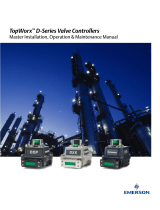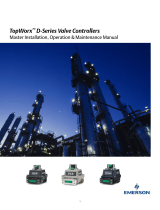Page is loading ...

Series 63 High-Flow Solenoid Valve
Installation, Operation and Maintenance Manual
All information herein is proprietary and confidential and may not be copied or reproduced without the expressed written consent of BRAY INTERNATIONAL, Inc.
The technical data herein is for general information only. Product suitability should be based solely upon customer’s detailed knowledge and experience with their application. 09_2020
Description
The Bray Series 63 high-flow solenoid valves have an aluminum body
and mounting interface pattern conforming to NAMUR for direct
installation. The Bray Series 63 is IP65 for DIN model (Figure 1) or
NEMA 4, 4x for flying leads model (Figure 2).
The Bray Series 63 solenoid can be used either with Single Acting/Spring
Return or Double Acting/Direct Acting actuators. Double Acting actuators
use the 5/2 configuration (Figure 3) and requires no adapter kit. Spring
Return actuators use the 3/2 configuration (Figure 4) and require the use
of a conversion kit included in the package. This kit includes an airflow
plate, O-ring seal and longer screws.
WARNING
Installation and maintenance of the solenoid valve must be carried
out by qualified personnel only.
Electrical connections are only to be made by trained personnel and
in accordance with the applicable regulations and standards.
Storage
Bray Series 63 is not weatherproof until the unit is properly installed,
or all conduits and applicable port connections are sealed off and
prepared for storage. The units may be shipped with temporary covers
to prevent foreign matter from entering through the conduit openings;
however, the user is responsible for replacing with the proper sealing
plugs to support its NEMA/IP ratings.
To prevent condensation from forming inside the unit, maintain a near
constant external temperature and store indoors in a well ventilated,
clean, dry room. The temperature shall be between 40°F (4°C) and 85°F
(29°C), with a relative humidity less than 70%. Store units away from
vibration and direct sunlight exposure, and place units on a shelf or
wooden pallet in order to protect against dampness. Keep units covered
to protect against dust and dirt; if storing for long term, placing the
unit inside a plastic sealed bag may be preferred.
Bray cannot accept responsibility for deterioration caused on-site once
the cover is removed or due to improper storage.
Installation
Valves are designed to be operated within the technical characteristics
specified on the nameplate. Bray reserves the right to change or modify
product design without prior notice.
These valves are pilot operated and require a minimum supply air
pressure of 22 psi (1.5 bar) to function. Do not exceed the maximum
allowable pressure of 130 psi (9 bar). These valves are designed to
operate with filtered air or inert gas (e.g. Nitrogen). Operating ambient
temperature range is -13°F to +140°F (-25°C to +60°C).
Before mounting the solenoid spool valve assembly on the actuator,
it must be configured for the required function.
• For 5/2 Double Acting/Direct Acting 4-Way:
The solenoid spool valve assembly mounts directly to the actuator
with 2 screws (#10-32 x 1 1/8” length or M5x.8 x 30mm length,
depending on actuator drilling) screws and O-rings as shown in
Figure 3. No conversion kit is required.
• For 3/2 Single Acting/Spring Return 3-Way:
Use the 4-way to 3-way conversion kit (flow plate, O-ring and 2
longer screws (#10-32 x 1 3/8” length or M5x.8 x 35mm length,
depending on actuator drilling). Install the kit between the solenoid
pilot valve and actuator as shown in Figure 4. The 4-way solenoid
configuration may be used without the conversion kit to operate
a Single Acting actuator – and would result in an “air assisted”
spring return action.
Connect pipes with the required functions in accordance with this
documentation and port markings on the valve. Make sure no
foreign matter enters the system. Use of a coalescing filter regulator
is recommended.
Correctly support the supply piping to avoid subjecting the solenoid
spool valve assembly to mechanical stress, when tightening, avoid
using the valve as a lever. Use proper tools and locate wrenches as
close as possible to the connection point. To avoid damage of the
equipment, DO NOT OVER TIGHTEN pipe connections.
Pneumatic Connections
• Connect supply pipes in accordance with the markings on the
nameplate
- 5/2 Double Acting/Direct Acting configuration: Supply
pressure to Port 1 (¼" NPT). Exhaust both Ports 3 and 5
(¼" NPT). Refer to Figure 5 for the 5/2 schematic.
- 3/2 Single Acting/Spring Return configuration: Supply
pressure to Port 1 (¼" NPT), Exhaust to Port 3 (¼" NPT). It
is recommended to protect Port 5 (when not used) with a
vented pipe plug or screen, do not plug completely. Refer
to Figure 6 for the 3/2 schematic.
- NOTE: The DIN model is also available with G1/4" metric
ports.
Manual Override
The solenoid is equipped with a Manual Override. Please refer to Figure
1 and 2 for the location of the manual override button.
To engage the Override, depress the red manual override button and
rotate 90° clockwise. The override will lock in place, causing the spool
valve to activate. The button can also be pressed to activate the spool
momentarily.
To disengage the Override, rotate the red manual override button
counterclockwise 90°. The manual override button will pop out, and
the spool will deactivate and return to the normal position.
To prevent injury or damage and to ensure correct operation of the
solenoid valve, the Manual Override button must be returned to the
normal (disengaged) position by rotating it 90° counterclockwise.

Series 63 High-Flow Solenoid Valve
Installation, Operation and Maintenance Manual
All information herein is proprietary and confidential and may not be copied or reproduced without the expressed written consent of BRAY INTERNATIONAL, Inc.
The technical data herein is for general information only. Product suitability should be based solely upon customer’s detailed knowledge and experience with their application. 09_2020
Electrical Connections
•
Depending on the voltage, electrical components must be provided
with a ground/earth connection and satisfy local regulations and
standards.
3-wire flying leads coil (NEMA 4, 4X)
- 2 red wires for power, 1 yellow/green wire for ground/
earth
• DIN type coil (IP65)
- 3 prong DIN 43650 Connector Form B Type I
Before work, switch off the electrical power supply to de-energize
all components.
The Bray Series 63 solenoid valve is designed for continuous duty
service. To avoid any possibility of damage or injury, do not touch the
solenoid which can become hot under normal operating conditions.
If the solenoid valve is easily accessible, the installer must provide
protection against accidental contact.
Maintenance
•
WARNING
Prior to any maintenance work or returning to operation, shut off
supply to the pilot solenoid valve, depressurize and vent the valve
in order to prevent injury or damage.
Cleaning: Maintenance of the valve depends on the operating
conditions. They must be cleaned at regular intervals. During
servicing, the components must be checked for excessive wear.
If operation cycle is slow, ensure proper supply pressure and that
there is no unusual noise or leak detected.
• Sound Emission: The sound emission depends on the application,
supply medium and nature of the equipment used. Exact
determination of the sound level can only be carried out by the
user having the valve installed in their system.
• Preventive Maintenance: Operate the pilot solenoid valve
monthly to check function. Should any difficulties or questions
arise during installation and maintenance, please contact a Bray
representative.
Troubleshooting:
• Incorrect exhaust pressure:
- Check that the air supply is within the minimum (22 psi,
1.5 bar) and maximum (130 psi, 9 bar) operating pressure.
- Use a filter regulator if the air supply is not consistent.
• Pilot valve does not operate:
- Check that the manual override is disengaged.
- Ensure that the air supply meets the minimum pressure.
Tools Required
• Phillips cross drive (#2) screwdriver, to assemble the solenoid coil
to the pilot valve.
• Small flat blade (3/16") screwdriver, to engage or disengage the
manual red close button.
• 5/32" or 4mm hex screwdriver (Allen wrench), to fasten the
solenoid pilot valve to the pneumatic actuator.

Series 63 High-Flow Solenoid Valve
Installation, Operation and Maintenance Manual
Single Coil
3 1
2
Dual Coil
2
13
Single Coil
2 4
513
Dual Coil
3 1 5
4
2
Figure 1: DIN Solenoid
Figure 3: 5/2 Installation
Figure 5: Schematics for 5/2
Figure 6: Schematics for 3/2Figure 4: 3/2 Installation
Figure 2: NEMA Solenoid
Single Coil
3 1
2
Dual Coil
2
13
Single Coil
2 4
513
Dual Coil
3 1 5
4
2
Manual Override
Manual Override
All statements, technical information, and recommendations in this bulletin
are for general use only. Consult Bray representatives or factory for the specific
requirements and material selection for your intended application. The right
to change or modify product design or product without prior notice is reserved.
Patents issued and applied for worldwide.
US HEADQUARTERS
Bray International, Inc.
13333 Westland East Blvd.
Houston, Texas 77041
Tel: 281.894.5454 Bray® is a registered trademark of Bray International, Inc.
© 2020 Bray International, Inc. All rights reserved.
IOM_Series 63 Solenoid_09-25-2020
/


